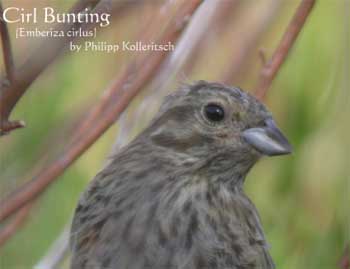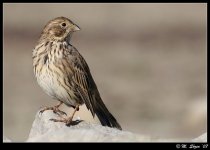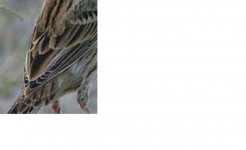-
Welcome to BirdForum, the internet's largest birding community with thousands of members from all over the world. The forums are dedicated to wild birds, birding, binoculars and equipment and all that goes with it.
Please register for an account to take part in the discussions in the forum, post your pictures in the gallery and more.
You are using an out of date browser. It may not display this or other websites correctly.
You should upgrade or use an alternative browser.
You should upgrade or use an alternative browser.
(?) Bunting ID (2 Viewers)
- Thread starter Steve G
- Start date
More options
Who Replied?CJW
Hit-and-run WUM
Interesting, thanks.
Have a look at this link. I know it's only a 'query' Pallas' but it shows flank streaking, however I'll bow to you superior knowledge.
http://members.aol.com/jrhough1/Pallass.jpg
Have a look at this link. I know it's only a 'query' Pallas' but it shows flank streaking, however I'll bow to you superior knowledge.
http://members.aol.com/jrhough1/Pallass.jpg
I've a feeling this bird was actually accepted as the first for Nepal. Dark flanks streaking is a characteristic of juvenile birds but adults have no flanks streaking, or if they do it is diffuse and a pale orange rufous colour.
The Nepal bird may be retaining juvenile body plumage (which would be odd at the date) or may have grown second generation feathers similar in pattern to juvenile feathers (possible?). I notice that the descriptions of the flanks and the illustrations of this do not coincide well!
The bill structure is shown well and clearly differs from the Lesvos bird.
Spud
The Nepal bird may be retaining juvenile body plumage (which would be odd at the date) or may have grown second generation feathers similar in pattern to juvenile feathers (possible?). I notice that the descriptions of the flanks and the illustrations of this do not coincide well!
The bill structure is shown well and clearly differs from the Lesvos bird.
Spud
gerdwichers8
Well-known member
Jane Turner
Well-known member
How common is white(ish) outer TF on Corn Bunting?
Or is it just very old faded feathers?
Or is it just very old faded feathers?
Jane Turner
Well-known member
Here is another allegedly yellow-less, chunky-billed Cirl - this time with a very convincing head-pattern


Last edited:
JANJ
Well-known member
Good point Jane - Corn Buntings normally lack white in tail. Check these and note the pale outer tf:
http://www.stevenround-birdphotography.com/Corn Bunting.htm
http://www.microbirding.se/ystad/images/pictures/Kornsparv050306_AA.jpg
JanJ
http://www.stevenround-birdphotography.com/Corn Bunting.htm
http://www.microbirding.se/ystad/images/pictures/Kornsparv050306_AA.jpg
JanJ
Jane Turner
Well-known member
Also the bill colour and big rusty tertial/covert fringes? Mantle lines look a bit strong too.
Motmot
Eduardo Amengual
I think it can be a young moulting bird. When Corn Buntings leave their nests they show paler than adults outer tail feathers but the quality of these is very bad (they perform a full moult a couple of months later). These feathers are worn in a short time, by August they can look very pale and worn as the subject bird shows.
See this recently fledged spanish bird to see the pale OTF:
http://www.anillamiento.net/guia/details.php?image_id=1754
Also bill colour fits young bird.
http://www.anillamiento.net/guia/details.php?image_id=1752
See this recently fledged spanish bird to see the pale OTF:
http://www.anillamiento.net/guia/details.php?image_id=1754
Also bill colour fits young bird.
http://www.anillamiento.net/guia/details.php?image_id=1752
gerdwichers8
Well-known member
In the beginning of August, Corn Bunting are found in heavy moult in Turkey which seems to be the case in this bird: inner rectrices are newly moulted feathers, the outer ones are old and faded. Not white but indeed faded!
Jane Turner
Well-known member
Surely this bird is an adult though?
Motmot
Eduardo Amengual
Surely this bird is an adult though?
No, I think is a young bird moulting into first winter plumage=adult, its outer tail feathers still juvenile and already worn in August
Last edited:
Jane Turner
Well-known member
The photo was taken in Aug - though Corn Bunt does have a full post juv moult, the fading on the old primary (longest/outermost showing) seems a bit much for say 5 weeks.
Motmot
Eduardo Amengual
Maybe but look at the unmoulted primaries, they look brown but fine. Check this tail and wing tip of an adult in August:
http://www.anillamiento.net/guia/details.php?image_id=1749
http://www.anillamiento.net/guia/details.php?image_id=1749
Last edited by a moderator:
Jane Turner
Well-known member
Motmot; said:Maybe but look at the unmoulted primaries, they look brown but fine. Check this tail and wing tip of an adult in August:
http://www.anillamiento.net/guia/details.php?image_id=1749
Was that caught by hand - it looks like it couldn't fly!!
You are right - the unmoulted primary is very much paler, but also hardly worn at all. Seen close up, the remaining tertials still look surprisingly chestnuty for a Corn Bunting and the mantle looks like it has lines as opposed to fine streaks.
Attachments
Motmot
Eduardo Amengual
Yes, those lines on the mantle look strange on a Corn...also those pointed looking tertials don´t look too good on a Corn...mmmmmh
Lots of pics of young and adult (January) CornBs in this link:
Sorry changed the link
http://www.ibercajalav.net/img/454_Miliaria_calandra.pdf
Lots of pics of young and adult (January) CornBs in this link:
Sorry changed the link
http://www.ibercajalav.net/img/454_Miliaria_calandra.pdf
Jane Turner
Well-known member
and furthermore it would be very unlike spud to be wrong 
Users who are viewing this thread
Total: 3 (members: 0, guests: 3)





